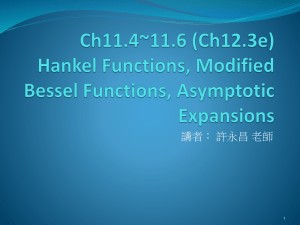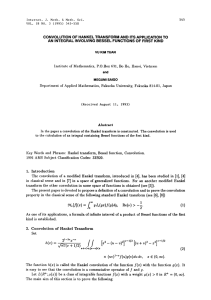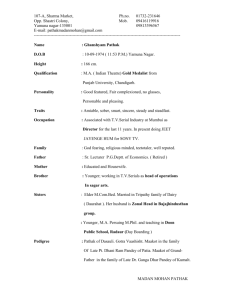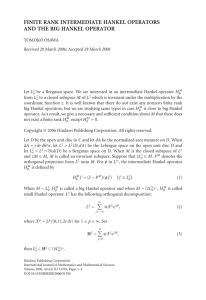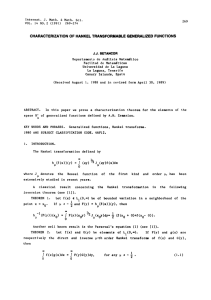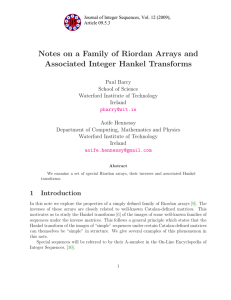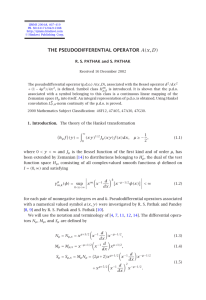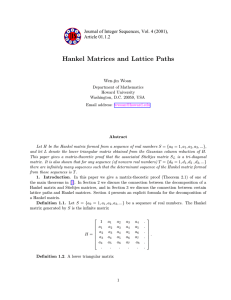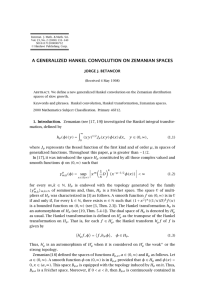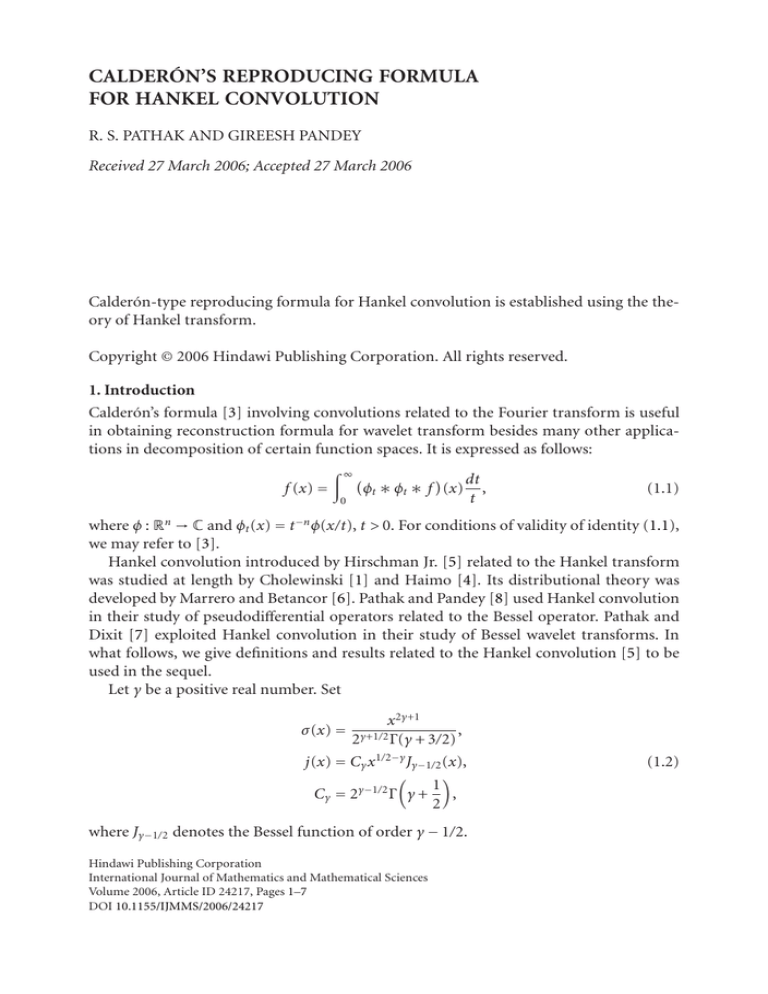
CALDERÓN’S REPRODUCING FORMULA
FOR HANKEL CONVOLUTION
R. S. PATHAK AND GIREESH PANDEY
Received 27 March 2006; Accepted 27 March 2006
Calderón-type reproducing formula for Hankel convolution is established using the theory of Hankel transform.
Copyright © 2006 Hindawi Publishing Corporation. All rights reserved.
1. Introduction
Calderón’s formula [3] involving convolutions related to the Fourier transform is useful
in obtaining reconstruction formula for wavelet transform besides many other applications in decomposition of certain function spaces. It is expressed as follows:
f (x) =
∞
0
φt ∗ φt ∗ f (x)
dt
,
t
(1.1)
where φ : Rn → C and φt (x) = t −n φ(x/t), t > 0. For conditions of validity of identity (1.1),
we may refer to [3].
Hankel convolution introduced by Hirschman Jr. [5] related to the Hankel transform
was studied at length by Cholewinski [1] and Haimo [4]. Its distributional theory was
developed by Marrero and Betancor [6]. Pathak and Pandey [8] used Hankel convolution
in their study of pseudodifferential operators related to the Bessel operator. Pathak and
Dixit [7] exploited Hankel convolution in their study of Bessel wavelet transforms. In
what follows, we give definitions and results related to the Hankel convolution [5] to be
used in the sequel.
Let γ be a positive real number. Set
σ(x) =
x2γ+1
,
2γ+1/2 Γ(γ + 3/2)
j(x) = Cγ x1/2−γ Jγ−1/2 (x),
Cγ = 2γ−1/2 Γ γ +
1
,
2
where Jγ−1/2 denotes the Bessel function of order γ − 1/2.
Hindawi Publishing Corporation
International Journal of Mathematics and Mathematical Sciences
Volume 2006, Article ID 24217, Pages 1–7
DOI 10.1155/IJMMS/2006/24217
(1.2)
2
Calderón’s formula
We define L p,σ (0, ∞), 1 ≤ p ≤ ∞, as the space of those real measurable functions φ on
(0, ∞) for which
φ p,σ =
∞
0
φ(x) p dσ(x)
1/ p
< ∞,
1 ≤ p < ∞,
(1.3)
φ∞,σ = ess sup |φ(x)| < ∞.
0<x<∞
For each φ ∈ L1,σ (0, ∞), the Hankel transform of φ is defined by
∞
Ᏼ(φ) = φ(x)
=
0
j(xt)φ(t)dσ(t),
0 ≤ x < ∞.
(1.4)
From [5, page 314], we know that φ
is bounded and continuous on [0, ∞) and
φ
∞,σ ≤ φ1,σ .
(1.5)
∈ L1,σ (0, ∞), then, by inversion, we have [5, page 316]
If φ(x) ∈ L1,σ (0, ∞) and if φ(t)
φ(x) =
∞
0
j(xt)φ(t)dσ(t),
0 < x < ∞.
(1.6)
If φ(x) and ψ(x) are in L1,σ (0, ∞), then the following Parseval formula also holds [10,
page 127]:
∞
0
ψ(t)dσ(t)
φ(t)
=
∞
0
φ(x)ψ(x)dσ(x).
(1.7)
To introduce Hankel convolution #, we define
D(x, y,z) =
∞
=2
0
j(xt) j(yt) j(zt)dσ(t)
3γ−5/2
1
Γ γ+
2
2
Γ(γ)π
1/2 −1
(xyz)
−2γ+1
Δ(xyz)
2γ−2
(1.8)
,
where Δ(xyz) denotes the area of triangle with sides x, y, z if such a triangle exists and
zero otherwise. Clearly D(x, y,z) ≥ 0 and is symmetric in x, y, z. Applying inversion formulae (1.6) to (1.8), we get
∞
0
D(x, y,z) j(zt)dσ(z) = j(xt) j(yt) 0 < x, y < ∞, 0 ≤ t < ∞.
Now setting t = 0, we obtain
∞
0
D(x, y,z)dσ(z) = 1.
(1.9)
(1.10)
Let p, q,r ∈ [1, ∞) and 1/r = 1/ p + 1/q − 1. The Hankel convolution of φ ∈ L p,σ (0, ∞) and
ψ ∈ Lq,σ (0, ∞) is defined by [5, page 311]
(φ#ψ)(x) =
∞∞
0
0
φ(y)ψ(z)D(x, y,z)dσ(y)dσ(z).
(1.11)
R. S. Pathak and G. Pandey 3
By [9, page 179], the integral is convergent for almost all x ∈ (0, ∞) and
φ#ψ r,σ ≤ φ p,σ ψ q,σ .
(1.12)
Moreover, if p = ∞, then (φ#ψ)(x) is defined for all x ∈ (0, ∞) and is continuous. If φ,ψ ∈
L1,σ (0, ∞), then from [5, page 314]
= φ(t)
ψ(t),
(φ#ψ)(t)
0 ≤ t < ∞.
(1.13)
In this paper, Hankel dilation Ᏸa is defined by
Ᏸa φ(x) = φa (x) = a−2γ−1 φ
x
,
a
a > 0.
(1.14)
2. Calderón’s formula
In this section, we obtain Calderón’s reproducing identity using the properties of Hankel
transform and Hankel convolutions.
Theorem 2.1. Let φ and ψ ∈ L1,σ (0, ∞) be such that following admissibility condition holds:
∞
0
ψ(ξ)
φ(ξ)
dσ(ξ)
=1
ξ 2γ+1
(2.1)
for all ξ ∈ (0, ∞). Then the following Calderón’s reproducing identity holds:
f (x) =
∞
0
f #φa #ψa (x)
dσ(a)
a2γ+1
∀ f ∈ L1 (R).
(2.2)
Proof. Taking Hankel transform of the right-hand side of (2.2), we get
Ᏼ
∞
0
=
f #φa #ψa (x)
∞
0
dσ(a)
a2γ+1
dσ(a)
f
(ξ)φ
a (ξ)ψ
a (ξ) 2γ+1 = f
(ξ)
= f
(ξ)
∞
0
a
φ(aξ)
ψ(aξ)
∞
0
φ
a (ξ)ψ
a (ξ)
dσ(a)
a2γ+1
(2.3)
dσ(a) = f (ξ).
a2γ+1
Now, by putting aξ = ω, we get
∞
0
φ(aξ)
ψ(aξ)
dσ(a)
=
a2γ+1
=
∞
0
∞
0
ψ(ω)
φ(ω)
dσ(ω/ξ)
(ω/ξ)2γ+1
ψ(ω)
φ(ω)
dσ(ω)
ω2γ+1
(2.4)
= 1.
Hence, the result follows.
The equality (2.2) can be interpreted in the following L2 - sense.
4
Calderón’s formula
Theorem 2.2. Suppose φ ∈ L1,σ (0, ∞) is real valued and satisfies
∞
0
φ(aξ)
2 dσ(a)
a2γ+1
= 1.
(2.5)
For f ∈ L1,σ (0, ∞) ∩ L2,σ (0, ∞), suppose that
f,δ (x) =
δ
f #φa #φa (x)
dσ(a)
.
a2γ+1
(2.6)
Then f − f,δ 2,σ → 0 as → 0 and δ → ∞.
Proof. Taking Hankel transform of both sides of (2.6) and using Fubini’s theorem, we get
f
,δ (ξ) = f
(ξ)
δ
φ(aξ)
2 dσ(a)
.
(2.7)
≤ φa #φa 1,σ f 2,σ
2
≤ φa 1,σ f 2,σ .
(2.8)
a2γ+1
By [5, page 311], we have
φa #φa # f 2,σ
Now using above inequality and Minkowski’s inequality [2, page 41], we get
∞
δ
2
dσ(a) a2γ+1 0
δ∞
φa #φa # f (x)2 dσ(x) dσ(a)
≤
a2γ+1
0
δ
φa #φa # f (x) dσ(a)
≤
2,σ 2γ+1
a
δ
2
dt
≤ φa 1,σ f 2,σ
t
δ
= φa 21,σ f 2,σ log
.
f 22,σ =
dσ(x)
φa #φa # f (x)
(2.9)
Hence, by Parseval formula (1.7), we get
lim f − f,δ 22,σ = lim f
− f
,δ 22,σ
→0
δ →∞
→0
δ →∞
∞
δ
2
2 dσ(a) f
(ξ) 1 −
dσ(x) = 0.
φ(aξ)
→0
a2γ+1 = lim
δ →∞
δ
0
(2.10)
2 (dσ(a)/a2γ+1 ))| ≤ | f
(ξ)|, therefore, by the dominated conver
Since | f
(ξ)(1 − [φ(aξ)]
gence theorem, the result follows.
The reproducing identity (2.2) holds in the pointwise sense under different sets of nice
conditions.
R. S. Pathak and G. Pandey 5
Theorem 2.3. Suppose f , f
∈ L1,σ (0, ∞). Let φ ∈ L1,σ (0, ∞) be real valued and satisfies
∞
0
φ(aξ)
2 dσ(a)
a2γ+1
= 1,
ξ ∈ R − {0 }.
(2.11)
Then
δ
lim
→0 δ →∞
f #φa #φa (x)
dσ(a)
= f (x).
a2γ+1
(2.12)
Proof. Let
f,δ (x) =
δ
dσ(a)
.
a2γ+1
(2.13)
≤ φa #φa 1,σ f 1,σ
2 ≤ φa 1,σ f 1,σ .
(2.14)
f #φa #φa (x)
By [5, page 311], we have
φa #φa # f 1,σ
Now,
f,δ 1,σ
=
≤
≤
∞
0
δ
dσ(a) dσ(x)
φ #φ # f (x) 2γ+1 a a
a
δ∞
δ
0
φa #φa # f (x)dσ(x) dσ(a)
a2γ+1
φa #φa # f (x)
2
≤ φa 1,σ f 1,σ
δ
1,σ
dσ(a)
a2γ+1
(2.15)
dt
t
2
δ
= φa 1,σ f 1,σ log
.
Therefore, f,δ ∈ L1 (0, ∞). Also using Fubini’s theorem and taking Hankel transform of
(2.13), we get
f
,δ (ξ) =
=
=
∞
0
δ
j(xξ)
δ∞
δ
0
φa #φa # f (x)
j(xξ) φa #φa # f (x)dσ(x)
dσ(a)
φ
a (ξ)φ
a (ξ) f
(ξ)
= f
(ξ)
δ
a2γ+1
φ(aξ)
2 dσ(a)
a2γ+1
.
dσ(a)
dσ(x)
a2γ+1
dσ(a)
a2γ+1
(2.16)
6
Calderón’s formula
Therefore, by (2.11), | f
,δ (ξ)| ≤ | f
(ξ)|. It follows that f
,δ ∈ L1,σ (0, ∞). By inversion, we
have
f (x) − f,δ (x) =
∞
0
j(xξ) f
(ξ) − f
,δ (ξ) dσ(ξ),
x ∈ (0, ∞).
(2.17)
Putting
h,δ (ξ;x) = j(xξ) f
(ξ) − f
,δ (ξ)
δ
2 dσ(a)
φ(aξ)
= j(xξ) f
(ξ) 1 −
2γ+1 ,
(2.18)
a
we get
f (x) − f,δ (x) =
=
∞
0
j(xξ) f
(ξ) − f
,δ (ξ) dσ(ξ)
∞
0
(2.19)
h,δ (ξ;x)dσ(ξ).
Now using (2.11) in (2.18), we get
lim h,δ (ξ;x) = 0,
→0
δ →∞
ξ ∈ R − {0 }.
(2.20)
Since |h,δ (ξ;x)| ≤ | f
(ξ)|, the Lebsegue dominated convergence theorem yields
lim f (x) − f,δ (x) = 0,
→0
δ →∞
∀x.
(2.21)
Acknowledgment
This work is supported by CSIR (New Delhi), Grant no. 9/13(04)/2003/ EMR-I.
References
[1] F. M. Cholewinski, A Hankel convolution complex inversion theory, Memoirs of the American
Mathematical Society 58 (1965), 67.
[2] H. L. Elliott and M. Loss, Analysis, Narosa Publishing House, New Delhi, 1997.
[3] M. Frazier, B. Jawerth, and G. Weiss, Littlewood-Paley Theory and the Study of Function Spaces,
CBMS Regional Conference Series in Mathematics, vol. 79, American Mathematical Society,
Rhode Island, 1991.
[4] D. T. Haimo, Integral equations associated with Hankel convolutions, Transactions of the American Mathematical Society 116 (1965), no. 4, 330–375.
[5] I. I. Hirschman Jr., Variation diminishing Hankel transforms, Journal d’Analyse Mathématique 8
(1960/1961), 307–336.
[6] I. Marrero and J. J. Betancor, Hankel convolution of generalized functions, Rendiconti di Matematica e delle sue Applicazioni. Serie VII 15 (1995), no. 3, 351–380.
[7] R. S. Pathak and M. M. Dixit, Continuous and discrete Bessel wavelet transforms, Journal of Computational and Applied Mathematics 160 (2003), no. 1-2, 241–250.
R. S. Pathak and G. Pandey 7
[8] R. S. Pathak and P. K. Pandey, A class of pseudo-differential operators associated with Bessel operators, Journal of Mathematical Analysis and Applications 196 (1995), no. 2, 736–747.
[9] K. Trimèche, Generalized Wavelets and Hypergroups, Gordon and Breach, Amsterdam, 1997.
[10] A. H. Zemanian, Generalized Integral Transformations, Pure and Applied Mathematics, vol. 18,
John Wiley & Sons, New York, 1968.
R. S. Pathak: Department of Mathematics, Banaras Hindu University, Varanasi 221005, India
E-mail address: ramshankarpathak@yahoo.co.in
Gireesh Pandey: Department of Mathematics, Banaras Hindu University, Varanasi 221005, India
E-mail address: gp2 bhu@yahoo.com

